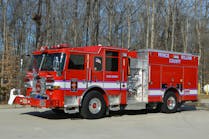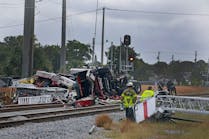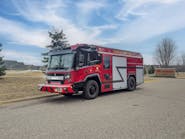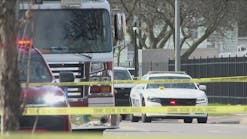The answer to the question in the headline, in most cases, is no one. It's ironic that the fire service of this country is responsible for public safety and yet when government passes regulations to provide highway and vehicle safety, the fire service runs to government for exemptions from the very regulations put in place for everybody's safety, firefighters and the public alike.
If you don't think we are unsafe, read any of the industry publications and you will see. It has been written that if the fire service of this country were a private corporation, we would be put out of business. Why? Because our death rate, injury rate and loss record are so great. Sad, but true. For many years, there were groups within the fire service voicing safety concerns, most notably the National Fire Protection Association (NFPA), International Association of Fire Fighters (IAFF) and International Association of Fire Chiefs (IAFC).
In many sectors the safety concerns voiced were ignored, so the federal government stepped in and created the Occupational Safety and Health Administration (OSHA). Many states have adopted OSHA regulations and imposed them on the fire service. Why? Because we in the fire service had an inability to police ourselves. Fire service injury and death rates were skyrocketing; the fire service was made aware of the facts but very little, if anything, was done to address these important safety issues. It was my experience that when OSHA was finally adopted in my state, many fire departments were compliant or almost compliant. However, there are some departments that would still be buying orange rubber gloves and rubber raincoats for interior structural firefighting if they could get away with it.
At least four driving-related regulations imposed by the federal or state governments were opposed by some in the fire service, who rushed out to seek exemptions.
The first regulation was the Commercial Vehicle Safety Act of 1986, enacted to provide highway safety and bar unsafe trucks and unsafe drivers. The fire service could not rush out fast enough to seek exemptions from this safety act. The reasons noted were for the financial and the administrative burdens it would have placed on fire departments, especially volunteers.
Administration of commercial driving license (CDL) programs is handled by each state's department of motor vehicles, so that's a moot point. But what about the financial burden that would be placed on the fire departments? With 90 percent of the fire protection for this country being provided by volunteers, saving billions of dollars a year on taxes, it seems the least each state could do is to provide no-cost CDLs to fire apparatus drivers. When I mentioned this at an emergency vehicle operations class, one of my students took exemption. He happened to be a professional truck driver and he was right. He said, "Why should fire apparatus operators take a road test on a fire truck and then be allowed to drive anything in that class?" The answer is simple, and already adopted by some states. The idea is to have a CDL with a fire apparatus endorsement. It would be no different than an air brake or a hazardous materials endorsement.
What does this mean for the fire service? Instead of exempting ourselves from vehicle safety, we have met the same minimum standards as any other commercial vehicle operator on the road. We have also proven to an independent third party that we are competent at what we do. What is the alternative?
In Pennsylvania, a fire chief can grant a certificate of authorization for a firefighter to drive fire apparatus without a CDL. We must then ask, who is the fire chief and what are his or her credentials? Does the fire chief have a commercial vehicle background, driven commercial vehicles before, have any understanding of the mechanics of a heavy truck or satisfactorily completed an emergency vehicle operator's course? Those questions all need to be answered.
Here is a perfect example of how flawed the system really is. I know of a fire chief whose last official act The sirens and with no inspection or registration. If you are driving fire apparatus that does not have a DOT heavy duty truck inspection, you are putting yourself and your fellow firefighters at risk.
The lack of fire apparatus inspections in this country is a big problem that was pointed out in a 1991 National Transportation and Safety Board Special Investigative Report of eight separate fire apparatus accidents. The two leading recommendations to the fire service were the mandatory use of seatbelts and annual apparatus inspection.
The next argument from fire departments is that we do our own in-house inspections and have our own mechanics and maintenance shops, so we do not need government regulations. That attitude is of little consolation to the families of two firefighters who died in Waterbury, CT, when the pumper in which they were riding lost its brakes and ended up into a tree. That pumper had at least 14 request-for-repair tickets at the Waterbury shops, some of which included requests to fix the brakes. After the accident, Connecticut initiated a voluntary non-fee inspection program for fire apparatus. The Connecticut Department of Motor Vehicles then inspected 559 fire apparatus from 64 cities and towns. Of those, 193 apparatus failed the roadside inspection. Fifty percent of the deficiencies involved brakes and 18 percent involved steering components. Ironi-cally, those two deficiencies were key factors in the fatal Waterbury crash.
The last regulation to be ignored involves mandatory random drug and alcohol testing. The DOT requires drug and alcohol testing as part of a CDL physical exam. Pilots, train engineers and bus drivers also must submit to testing. Even a local department of public works with fewer than 50 employees is mandated by a Jan. 1, 1996, federal law to institute a mandatory drug and alcohol testing and awareness program.
Most career fire departments require testing as part of a firefighter's condition of employment. However, the volunteer sector lags far behind here. It would seem we have our heads stuck in the sand on this issue. Where do firefighters come from? The answer: the general population. Does the general population of this country have an alcohol and drug problem? The answer is an overwhelming yes. The NFPA is coming out with a new standard NFPA 1451 Driving Risk Management Program for the fire service. I submitted a proposal for drug and alcohol testing to be included in that standard; it was denied. I also sent proposals on CDLs and apparatus inspections; they too were denied.
It is sad that with all the firefighter safety issues we have tackled, we ignore driving. Seeking exemptions from highway safety is no way to gain public confidence and trust with the motorists with whom we share the roads. Safety is an issue in which the fire service must be consistent. We cannot operate safely in one area of firefighting and then do a 180-degree turnabout and be unsafe in another.
Who regulates fire apparatus and their operators? Unfortunately, no one. We must change that. The life you might save may be yours or that of someone you know.
Michael Wilbur, a Firehouse® contributing editor, is an FDNY ladder company driver and a training officer of the Howells, NY, Fire Department. He is a New York State Academy of Fire Science adjunct instructor and has developed and presents emergency vehicle operations courses at the Orange County Fire Training Center and at national seminars and lectures.




